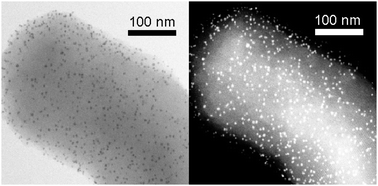The incorporation of various molecular metal clusters, with well defined stoichiometry, into M41S materials has been investigated. The grafting of simple metal clusters, such as [Ru3(CO)12] and [PPN]2[Fe4(CO)13], and the larger, and in one instance, bimetallic, clusters [(dppe)2Cu][Cu6Fe4(CO)16] and [PPh4][Ru10(μ6-C)(μ-H)(CO)24] has been achieved. Nanoparticles containing iron and platinum were also anchored on silaceous supports. The proportion of iron to platinum in FePt nanoparticles was adjusted by altering the molar ratios of starting materials. Consequently, ratios of Fe : Pt of 20 : 80, 27 : 73, 40 : 60, 53 : 47 and 64 : 36 were examined. The materials produced in this manner were characterised by Powder X-ray Diffraction (XRD), BET surface areas and Transmission Electron Microscopy (TEM) and elemental analysis. The FePt materials were also investigated for their magnetic properties by SQUID magnetometry. A number of the metal containing materials were investigated for their potential to produce hydrocarbons in the Fischer–Tropsch synthesis.

